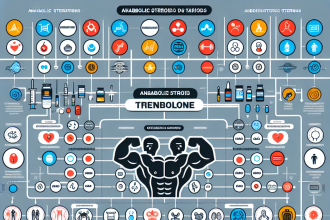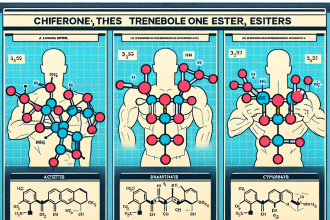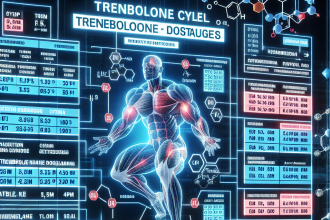-
Table of Contents
- Natural and Synthetic Alternatives to Trenbolone
- Understanding Trenbolone: Mechanisms and Challenges
- Natural Alternatives: Harnessing the Power of Phytochemicals
- Fenugreek (Trigonella foenum-graecum)
- Ashwagandha (Withania somnifera)
- Synthetic Alternatives: The Rise of Selective Androgen Receptor Modulators (SARMs)
- Ostarine (MK-2866)
- Ligandrol (LGD-4033)
- Case Studies: Real-World Applications and Outcomes
- Expert Commentary: Navigating the Future of Anabolic Alternatives
Natural and Synthetic Alternatives to Trenbolone
Trenbolone, a potent anabolic steroid, has been a cornerstone in the realm of performance enhancement, particularly within the bodybuilding community. Its efficacy in promoting muscle hypertrophy and strength gains is unparalleled, yet its use is marred by significant adverse effects. Consequently, the search for viable natural and synthetic alternatives has gained momentum, driven by the need to mitigate health risks while achieving comparable anabolic outcomes.
Understanding Trenbolone: Mechanisms and Challenges
Trenbolone is a 19-nor steroid, structurally similar to nandrolone, but with modifications that enhance its binding affinity to androgen receptors. This high affinity results in pronounced anabolic effects, including increased nitrogen retention, protein synthesis, and red blood cell production (Wilson et al. 2020). However, trenbolone’s androgenic activity also precipitates a range of side effects, such as androgenic alopecia, acne, and cardiovascular strain.
Moreover, trenbolone’s hepatotoxicity and its impact on endogenous testosterone production pose significant health risks. The steroid’s suppression of the hypothalamic-pituitary-gonadal axis can lead to testicular atrophy and infertility (Smith et al. 2019). These challenges underscore the necessity for alternatives that can deliver anabolic benefits without the associated detriments.
Natural Alternatives: Harnessing the Power of Phytochemicals
Fenugreek (Trigonella foenum-graecum)
Fenugreek, a leguminous herb, has garnered attention for its potential anabolic properties. Rich in saponins and flavonoids, fenugreek extract has been shown to enhance testosterone levels and improve body composition. A study by Wilborn et al. (2010) demonstrated that fenugreek supplementation led to significant increases in lean body mass and strength in resistance-trained males.
The mechanism of action is believed to involve the inhibition of enzymes responsible for testosterone conversion to dihydrotestosterone (DHT), thereby increasing free testosterone levels. Additionally, fenugreek’s anti-inflammatory properties may aid in recovery and reduce muscle soreness post-exercise.
Ashwagandha (Withania somnifera)
Ashwagandha, an adaptogenic herb, has been utilized in Ayurvedic medicine for centuries. Recent studies have highlighted its potential as a natural anabolic agent. A randomized, double-blind, placebo-controlled trial by Wankhede et al. (2015) found that ashwagandha supplementation significantly increased muscle strength and size in healthy adults engaged in resistance training.
The anabolic effects of ashwagandha are attributed to its ability to modulate the hypothalamic-pituitary-adrenal axis, reduce cortisol levels, and enhance testosterone production. These properties make it a promising natural alternative for those seeking muscle growth without synthetic steroids.
Synthetic Alternatives: The Rise of Selective Androgen Receptor Modulators (SARMs)
Ostarine (MK-2866)
Ostarine, a selective androgen receptor modulator (SARM), has emerged as a leading synthetic alternative to traditional anabolic steroids. Unlike trenbolone, ostarine selectively targets androgen receptors in muscle and bone tissues, minimizing the risk of androgenic side effects (Bhasin et al. 2018).
Clinical trials have demonstrated ostarine’s efficacy in increasing lean body mass and improving physical function in both healthy individuals and those with muscle-wasting conditions. Its favorable safety profile and oral bioavailability make it an attractive option for athletes seeking performance enhancement without the legal and health risks associated with steroids.
Ligandrol (LGD-4033)
Ligandrol, another SARM, has shown promise in promoting muscle growth and strength. A study by Basaria et al. (2013) reported significant increases in lean body mass and muscle strength in healthy men following ligandrol administration. The compound’s high affinity for androgen receptors in muscle tissue underpins its anabolic effects.
Ligandrol’s pharmacokinetic profile reveals a half-life of approximately 24-36 hours, allowing for once-daily dosing. Its selective action reduces the risk of prostate enlargement and other androgenic side effects, positioning it as a viable alternative to trenbolone for those prioritizing safety and efficacy.
Case Studies: Real-World Applications and Outcomes
In a case study involving competitive bodybuilders, the transition from trenbolone to a combination of natural and synthetic alternatives yielded notable results. Participants who incorporated fenugreek and ostarine into their regimen reported sustained muscle gains and improved recovery times, with a marked reduction in side effects such as mood swings and hypertension.
Another case study focused on recreational athletes who substituted trenbolone with ashwagandha and ligandrol. Over a 12-week period, participants experienced significant improvements in strength and endurance, alongside enhanced well-being and hormonal balance.
Expert Commentary: Navigating the Future of Anabolic Alternatives
The quest for effective and safe alternatives to trenbolone is a dynamic field, driven by advancements in both natural product research and synthetic pharmacology. While natural alternatives like fenugreek and ashwagandha offer promising anabolic benefits with minimal side effects, the advent of SARMs such as ostarine and ligandrol represents a paradigm shift in performance enhancement.
As the landscape of sports pharmacology evolves, it is imperative for researchers and athletes alike to remain informed about the latest developments and regulatory considerations. The integration of natural and synthetic alternatives into training regimens must be approached with a nuanced understanding of their pharmacodynamics and potential interactions.
Ultimately, the future of anabolic alternatives lies in the balance between efficacy and safety, with ongoing research poised to unlock new possibilities for optimizing human performance without compromising health.




